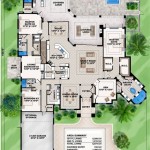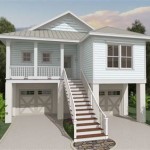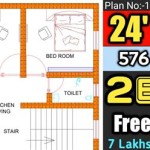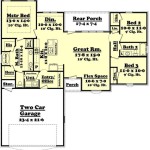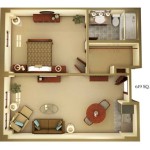Small House Floor Plan Design: Maximizing Space and Functionality
The allure of a smaller home is undeniable. Whether driven by financial considerations, a desire for simplified living, or environmental consciousness, the decision to downsize often necessitates a thoughtful and efficient approach to floor plan design. Small house floor plans present unique challenges and opportunities, demanding careful consideration of space allocation, functionality, and aesthetic appeal. This article will explore key aspects of designing small house floor plans, focusing on strategies to maximize space and create a comfortable and livable environment.
A successful small house floor plan transcends mere square footage limitations. It prioritizes usability, storage, and flow, ensuring that every inch of the home contributes to the overall living experience. Efficient design transforms a compact space from feeling cramped to feeling cozy and well-organized. This efficiency is achieved through a combination of smart planning, innovative design solutions, and a meticulous approach to material selection.
Prioritizing Open Concept Living
One of the most effective strategies for making a small house feel larger is the adoption of an open concept floor plan. By eliminating walls between key living areas such as the kitchen, dining area, and living room, a greater sense of spaciousness is achieved. This approach allows for natural light to permeate the entire area, further enhancing the feeling of openness.
Open concept designs require careful consideration of zoning and traffic flow. While walls are removed, it's important to define distinct functional areas within the open space. This can be achieved through the strategic placement of furniture, changes in flooring materials, or the use of partial walls or screens. For example, a kitchen island can serve as a visual and functional divider between the kitchen and living room, providing additional counter space and seating while simultaneously defining the cooking zone.
Consider the flow of movement within the open space. Common pathways should be clear and unobstructed, allowing for easy navigation between different areas. Avoid overcrowding the space with furniture; instead, opt for fewer, well-chosen pieces that serve multiple purposes. Multi-functional furniture, such as a sofa with hidden storage or a dining table that expands to accommodate guests, is particularly valuable in small spaces.
The downside of open concept living is the potential for noise and lack of privacy. Strategies to mitigate these issues include the use of sound-absorbing materials, such as rugs and upholstered furniture, and the incorporation of flexible partitions that can be used to create temporary separation when needed. Room dividers, curtains, or even strategically placed bookshelves can provide visual and acoustic privacy without completely closing off the space.
Maximizing Vertical Space and Storage
In small houses, every available inch counts. Utilizing vertical space for storage and functionality is crucial for maximizing the perceived and actual size of the home. This involves thinking beyond traditional horizontal storage solutions and exploring the opportunities that verticality offers.
Tall cabinets are an excellent way to maximize storage in kitchens and bathrooms. Extending cabinets to the ceiling eliminates wasted space and provides ample room for storing cookware, pantry items, or toiletries. Shelving units that reach to the ceiling can be used to display books, decorative items, or personal collections, adding visual interest and personality to the space.
Loft spaces are another popular strategy for maximizing vertical space. A loft can be used for sleeping, working, or storage, freeing up valuable floor space for other activities. Access to the loft can be provided via a ladder or a compact staircase, depending on the available space and the intended use of the loft area. Consider the ceiling height when designing a loft space to ensure adequate headroom and a comfortable living environment.
Built-in storage solutions are particularly effective in small houses. Built-in shelves, cabinets, and benches can be customized to fit the specific dimensions of the space, maximizing storage capacity and creating a seamless and integrated design. Under-stair storage is often overlooked but can provide valuable space for storing seasonal items, sports equipment, or household essentials.
Wall-mounted furniture, such as floating shelves and wall-mounted desks, can also help to free up floor space and create a more open and airy feel. By elevating furniture off the floor, you create the illusion of more space and make it easier to clean and maintain the area.
Consider incorporating storage into unexpected places. For instance, a platform bed can incorporate drawers or compartments underneath for storing bedding, clothing, or other items. Utilize the space above doorways for shelves to store less frequently used items. Thoughtful planning can reveal surprising opportunities for storage in even the smallest of spaces.
Strategic Use of Light and Color
Light and color play a critical role in shaping the perception of space. A well-lit and thoughtfully colored small house can feel significantly larger and more inviting than a poorly lit and darkly colored one.
Natural light is paramount. Maximize the amount of natural light entering the home by using large windows and skylights. Avoid heavy curtains or blinds that block natural light; instead, opt for sheer curtains or blinds that allow light to filter through while still providing privacy. Consider the orientation of the house when planning window placement to maximize sunlight exposure throughout the day.
Artificial lighting is also essential, particularly in areas that receive little natural light. Use a combination of ambient, task, and accent lighting to create a well-lit and visually appealing environment. Ambient lighting provides overall illumination, while task lighting focuses on specific areas such as work surfaces or reading nooks. Accent lighting highlights architectural features or decorative elements, adding depth and interest to the space.
Choose light and neutral colors for walls, ceilings, and floors to create a sense of spaciousness. Light colors reflect light, making the room feel brighter and larger. Avoid dark or bold colors, which can make the room feel smaller and more enclosed. Consider using a monochromatic color scheme, where different shades of the same color are used throughout the space, to create a cohesive and harmonious look.
While light colors dominate, strategic pops of color can add personality and visual interest to the space. Use colorful accessories, such as throw pillows, rugs, and artwork, to add vibrancy and energy to the room. Consider using a bold color on a feature wall to create a focal point and draw the eye upward, making the ceiling appear higher.
Mirrors are a powerful tool for creating the illusion of space. Place mirrors strategically to reflect light and visually expand the room. A large mirror on a wall can double the perceived size of the space, while smaller mirrors can be used to reflect natural light into darker corners.
In conclusion, designing a small house floor plan requires careful planning, creative problem-solving, and a meticulous attention to detail. By prioritizing open concept living, maximizing vertical space and storage, and strategically using light and color, one can transform a compact space into a comfortable, functional, and aesthetically pleasing home.

Small House Design 2024005 Pinoy Eplans Modern Plans Layout

Small House Design 2024001 Pinoy Eplans Floor Plans

Modelos De Casas 50 Metros Cuadrados Small House Blueprints Floor Plans Design

Small House Plan Examples

18 Small House Designs With Floor Plans And Decors

Two Bedroom Small House Design Shd 2024030 Pinoy Eplans

Small House Plans With S Houseplans Blog Com

Longshoremans Daughter Small House Floor Plans Tiny

Small House Designs Shd 2024003 Pinoy Eplans

Small House Plans And Design Ideas For A Comfortable Living

